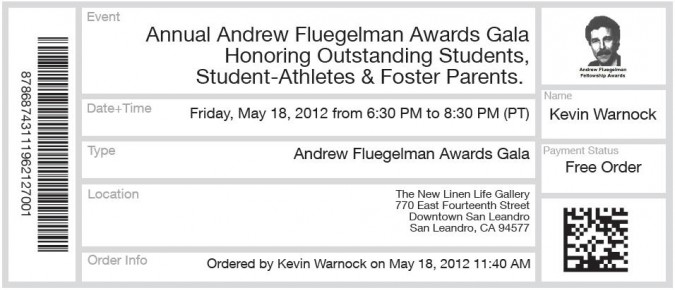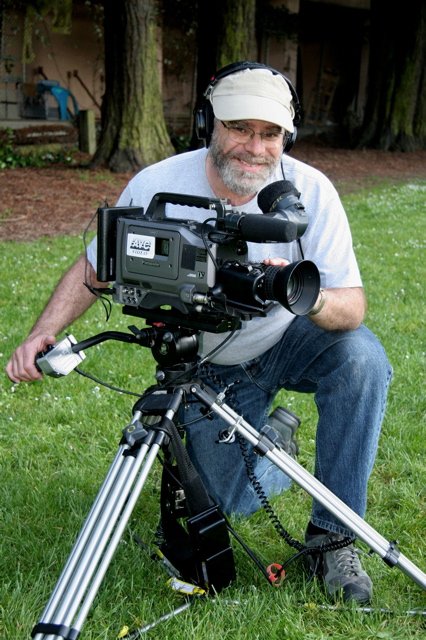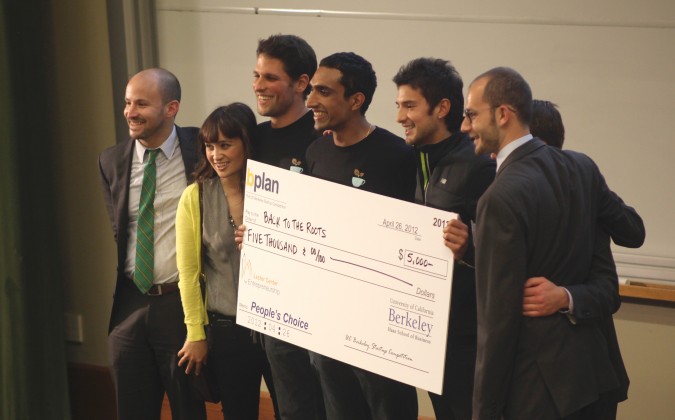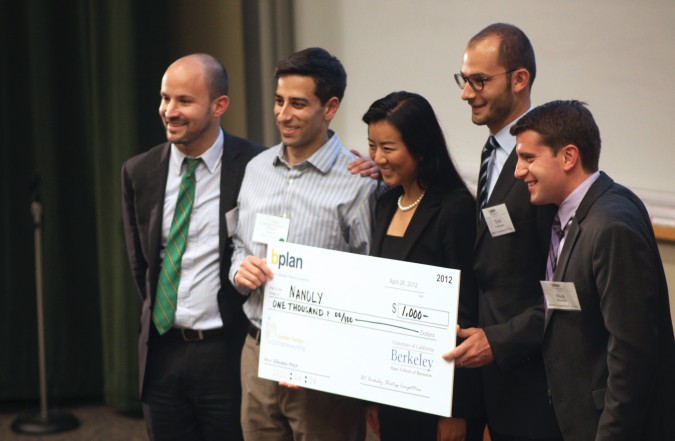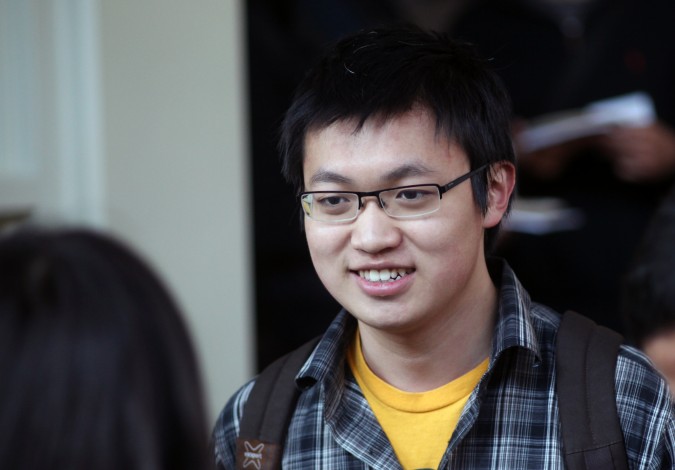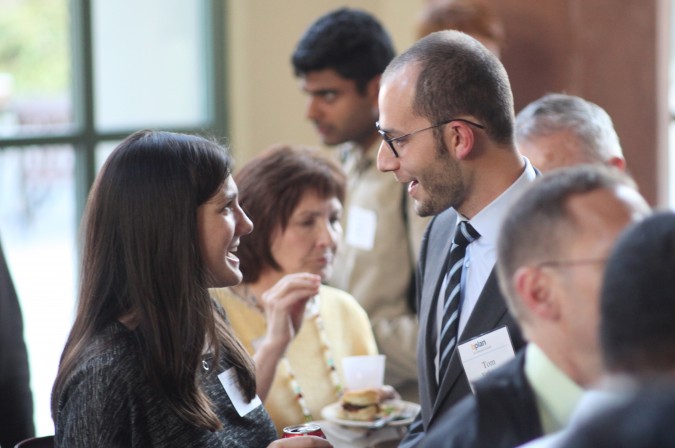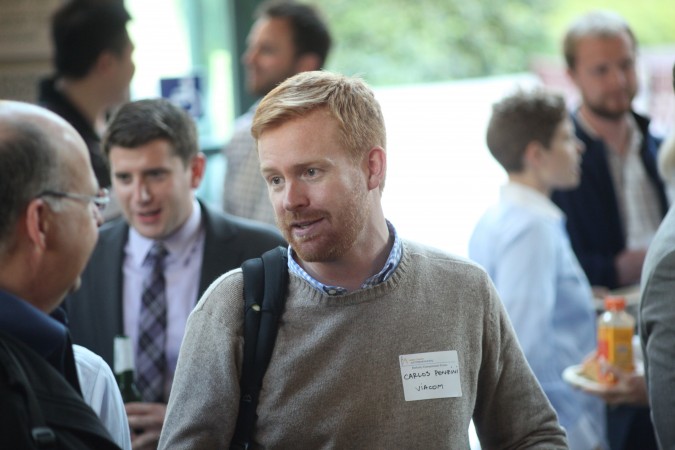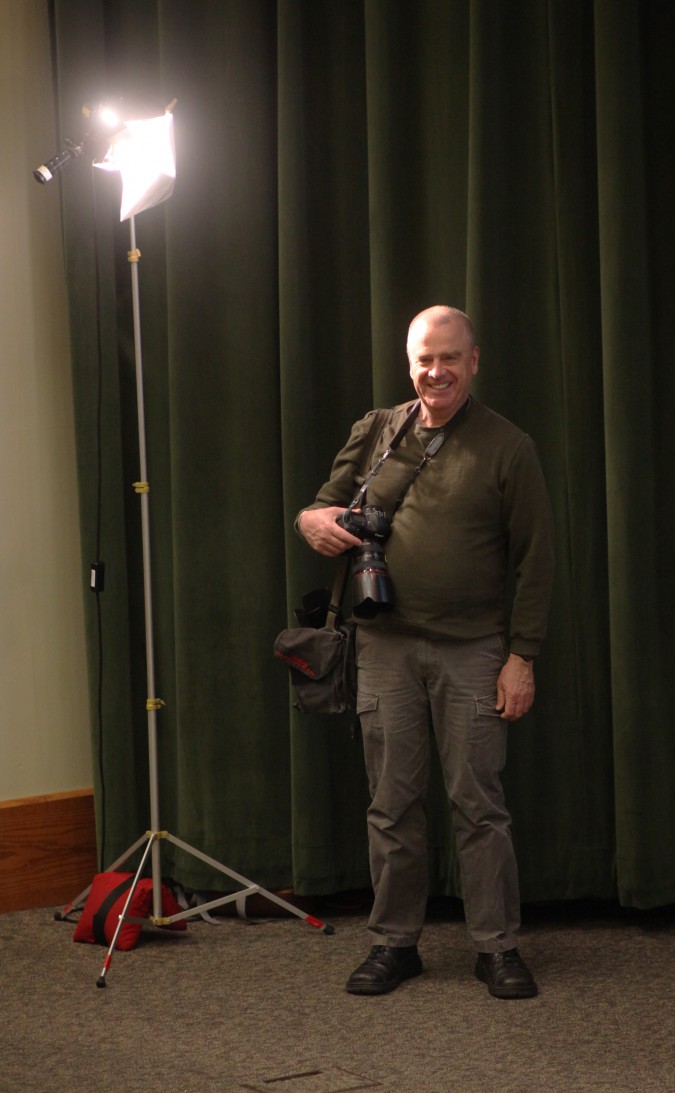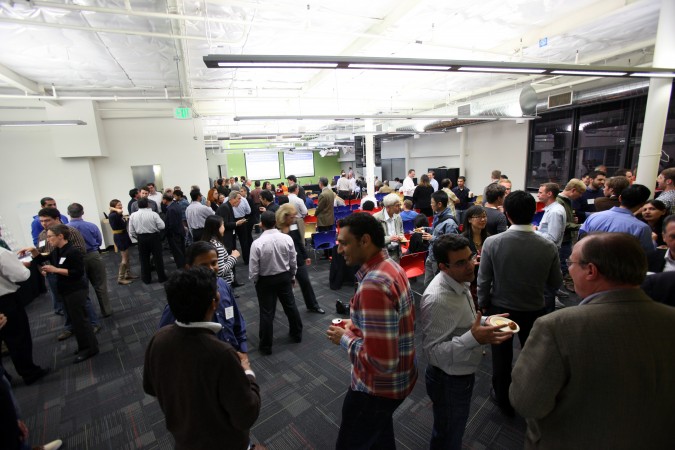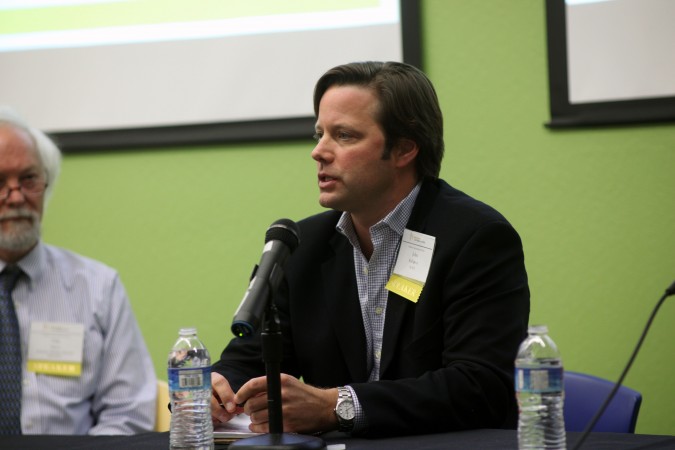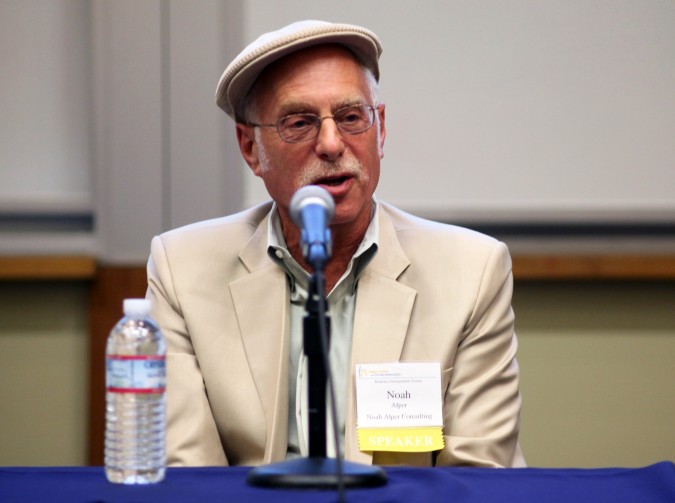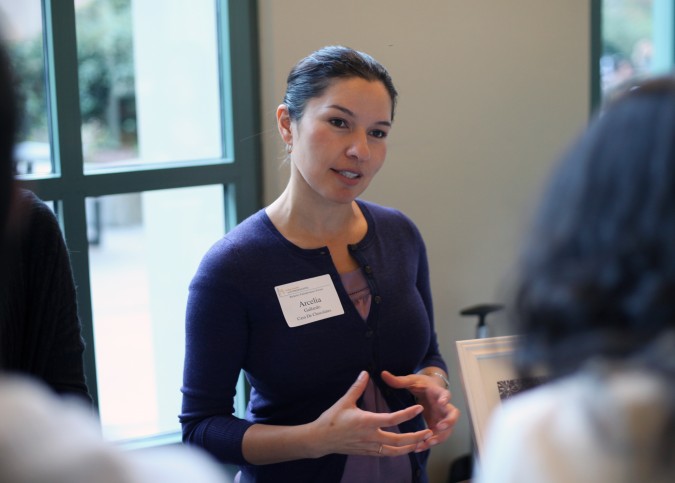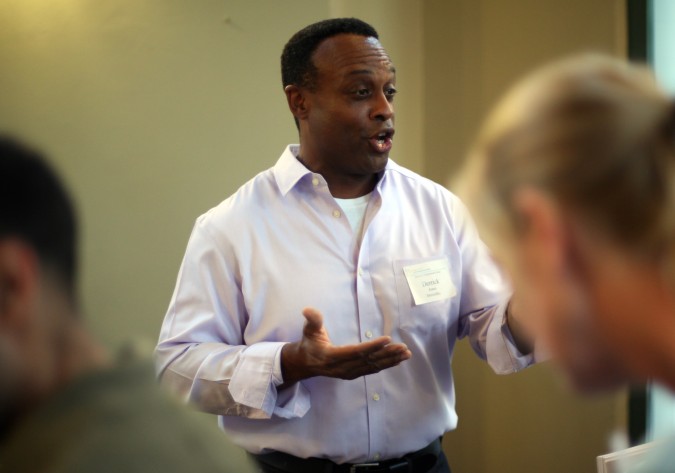Archive for the ‘berkeley entrepreneurs forum’ tag
Berkeley Entrepreneurs Forum, 2012-13 Angel & Venture Capital Financing Overview – August 30, 2012

The Berkeley Entrepreneurs Forum, August 30, 2012, held at Stanley Hall, room 105, because Anderson Auditorium was booked
On August 30, 2012 I attended the 2012-13 Angel & Venture Capital Financing Overview at The Berkeley Entrepreneurs Forum.
The August 30th Forum was the first of this academic year. The Berkeley Entrepreneurs Forum is a production of The Lester Center for Entrepreneurship & Innovation at the Haas School of Business at the University of California Berkeley.
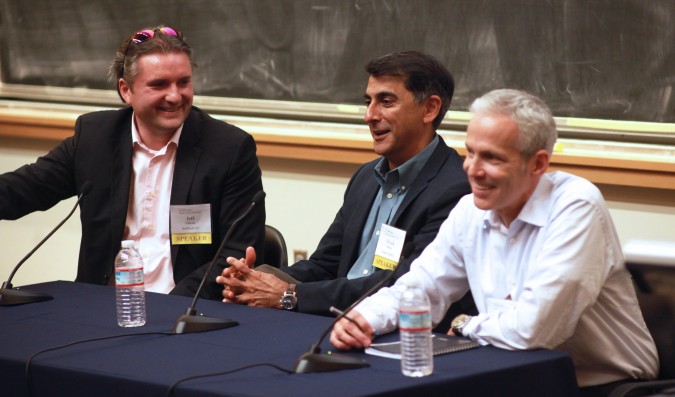
Panelists Jeff Clavier, Vivek Mehra and Jim Barnett at Berkeley Entrepreneurs Forum, August 30, 2012. Photo by Kevin Warnock.
The first Forum of the year for years now starts with Steve Bengston’s presentation of the Shaking the Money Tree report. I suspect Bengston has made this presentation hundreds of times, as he gives it not just at the Forum, but at many venues. In fact, I suspect it’s Bengston’s signature talk.
You can watch the full video of the Forum here to see what happened. I am a photographer, not a videographer. This is not the official video, which The Lester Center will publish in its entirety some weeks from now, I believe. I suggest you watch that version, because it will have professional sound from a mixing board, the slides will likely be full screen so you can read them, and the camera used is far better than the still camera I used that happens to also shoot video. I did not upload this video at full quality, since such video takes far longer to compress for Internet display.
There were some good lines from the speakers. I’ve transcribed my favorites here:
Steve Bengston:
“It [venture capital] finally got big in the mid to late 90s and now we worry when the venture business goes from $30B to $20B, but it never got above $20B until 1998 so the scale of the venture business is just much bigger than it’s ever been.”
“What about Series A, ‘didn’t that collapse?’ It is down certainly from the peak but you can see whatever that is there are $200M to $400M of series A deals each quarter just in Silicon Valley and that represents about 50 to about a 100 Series A deals in Silicon Valley each quarter.”
“The good news is there is a lot of money for your deal if you meet the certain metrics for an investor.”
“If you’re going to raise money which is still hard to do, you’re going to raise around $3M. That’s a typical deal. In this era, that buys you a lot more months of burn than it would have say ten years ago.”
“You have 300 to 400 M & A exits in the US a year in the US, much higher than the old days.”
“The top five or so [venture] firms are raising 80% of the money.”
“It begs the question ‘How many VCs do you need to find the 30 good companies every year?’ Right now the answer is about 3,000. For many people that seems high.”
“China has been the number one economy 15 of the last 18 centuries. So, just because they have had a couple of bad centuries you don’t want to count them out. They are used to being on top.”
Jeff Clavier:
“The challenge at the early stage is that even great founders can come up with really stupid ideas.”
“Do it because you are passionate about it, not because it’s cool.”
“I passed on airbnb that some showed me when it was called air bed and breakfast and I said ‘air bed and breakfast… are you f—ing kidding me?'”
Jim Barnett:
“One of the danger signs that all the partners look for is what we call ‘complexifiers’ — people that take what is otherwise a relatively simple business proposition or business idea and figure out how to make it complex.”
“The one thing I would say to those thinking about starting a company or planning to start a company is just go do it. Your idea really doesn’t need to be that great. It really doesn’t. If you’re great, it will get funded.”
“I want to dispell a myth that you learn more from your mistakes than you do from your successes. I think that is just a bunch of crap. I really do. I think you learn from watching success — pattern matching, whether it’s in sports whether it’s in business or anything else so for those of you that are in the audience that are MBAs or that are undergrads that are thinking about what do if they’re not going to start a company I would say ‘go work for a successful company and watch.’ You’ll learn a lot more than doing three failed startups.”
Vivek Mehra:
“I hate doing deals over the weekend. I have never done one and I hope I never have to do one. It’s just impossible to get to know the entrepreneur.”
“When there are very asymmetric equity assignments amongst the team you know what they really think about each other.”
Here is my succinct summary of this Entrepreneurs Forum:
- The venture industry is in trouble, but there is still plenty of money around.
- Lots of angel investors are making what will prove to be poor investments so this increases the chances that you can raise money even if you or your idea are not that good.
- There is a lot to be gained by just starting a company, so if you are passionate about doing so, then go for it. You won’t ruin your chances for future success by failing a few times.
- However, if you’re not going to start a company, you should work for a clearly successful company so you can pay attention and learn from the success of others.
- Surround yourself with high quality people.
- Don’t make things more complicated than they need to be.
- Have your role worked out with your founders before you pitch to investors. Lopsided equity divisions speak loudly to investors what you think of your co-founders.
- Increase your chances of getting funded by persistently pursuing entrepreneurship over years, so investors may gauge your actions over your words.
- Work hard and recognize that a lot of success may be attributed to your ability to forge healthy and respectful long term relationships with people in the community.

Panelist Jeff Clavier answers questions at the Berkeley Entrepreneurs Forum, August 30, 2012. Photo by Kevin Warnock.
From the Berkeley Entrepreneurs Forum website, here are the introductions for the moderator and speakers — I added the hyperlinks to make it easier for you to learn more about the panelists and their many interests:
Samuel B. Angus
Partner
Fenwick & West LLP
Samuel B. Angus is a partner in the Corporate and Venture Capital Group of Fenwick & West LLP, a law firm specializing in technology and life sciences matters. Mr. Angus is resident in the San Francisco office and his practice concentrates on advising start-up/venture-backed companies, venture capital and debt financings, mergers and acquisitions, intellectual property licensing, joint ventures and general corporate matters. Mr. Angus represents a broad range of companies from privately held start-up companies to publicly traded corporations, including Airbnb, Github, Marin Software and oDesk. His practice also includes advising entrepreneurs and investors.
Jim Barnett
Partner
Shasta Ventures
Jim Barnett is a Partner at Shasta Ventures and has been a highly successful serial CEO and entrepreneur. Jim is currently chairman and co-founder of Turn, chairman of Extole and Sojern, and a board member of Needle and RelayRides. From 2004 until 2009, Jim was CEO, chairman and co-founder of Turn, the leading platform for managing data driven digital advertising. Before that he was president of Overture Search, a division of Overture Services, Inc. Jim joined Overture via its acquisition of AltaVista Company, where he was president and CEO. In this role, he led the company’s successful turnaround and sale to Overture.
Jim was also president of Ancestry.com (MyFamily.com) and president and CEO of ThirdAge Media, which was acquired by Ancestry.com. Prior to that, Jim was president and CEO of Infogrammes North America, a leading global publisher of video games and entertainment software. He was also chairman, president and CEO of Accolade Inc, Infogrammes’ predecessor company, and prior to that was chief operating officer of an “Inc. 100 Fastest Growing Private Companies.”
Jim has served on the boards of many private and public companies including SideStep, Inc. where he was chairman and Petco where he was also an early investor. Jim earned a bachelor’s degree, MBA and J.D. from Stanford University.
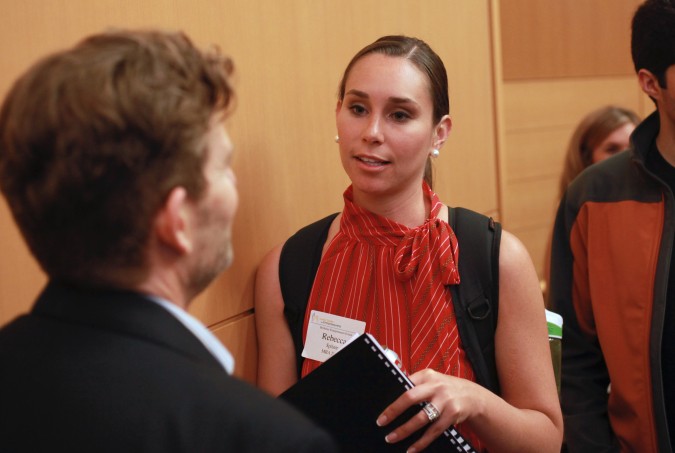
Moderator Sam Angus listens to student Rebecca Spitzer pitch her startup at the Berkeley Entrepreneurs Forum, August 30, 2012
Steve Bengston
PricewaterhouseCoopers
Steve Bengston heads the Emerging Company Services (ECS) group at PricewaterhouseCoopers. ECS acts as “mentor capitalists” for young, high potential companies.
Before joining PwC, Steve had 20 years of experience in a variety of marketing, business development and general management roles at several high tech companies in the Bay Area. Most recently, he was Pres/CEO of ynot.com [Note: not the website now online at that URL], a leading international emarketing and greeting card company. Previously, he was VP Marketing & Business Development at Worldview Systems, an Internet travel pioneer. At Worldview, Steve helped launch and market Travelocity with Sabre Interactive.
Steve has a BA in Economics and MBA from Stanford University. He works closely or sits on the Advisory Board at Churchill Club, SVASE, Life Science Angels, Bay Bio, and the Stanford/MIT Venture Lab, has taught classes on startups at UC Berkeley, San Jose State, Santa Clara Law School, Hastings Law School, and Stanford, and is active in a variety of other organizations in the Bay Area targeting entrepreneurs and investors. He is a frequent moderator/panelist at both university and industry sponsored events.
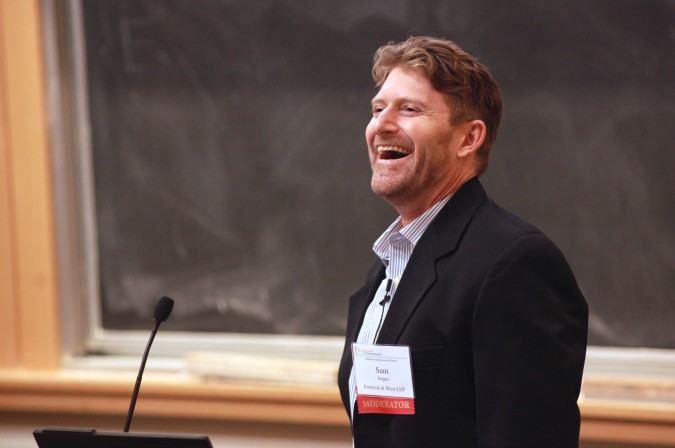
Sam Angus, a partner at law firm Fenwick & West LLP, moderates a panel at the Berkeley Entrepreneurs Forum, August 30, 2012
Jeff Clavier
Founder and Managing Partner
SoftTech VC
Based in Palo Alto, California, Jean-Francois “Jeff” Clavier is the Founder and Managing Partner of SoftTech VC, one of the most active seed stage investors in Web 2.0 startups. Since 2004, Jeff has invested 125 consumer internet startups (Fund I, Fund II, Fund III) in areas like social media, monetization, search, gaming or B2B/B2C web services. These investments are typically located in Silicon Valley, New-York and Boulder. With over 20 years of operational, entrepreneurial and venture capital experience, Jeff is able to add relevant perspective and value to his companies as they grow from inception to maturity, and hopefully, success.
Jeff was recognized as one of the 13 “Web 2.0 King Makers” by (late) Business 2.0. BusinessWeek named him one of “The 25 Most Influential People on the Web” in 2008, and one of the “Top 25 Angels in Tech” in 2010. He was also nominated in the “Best Angel” category at the Crunchies in 2009 and 2010. He is often noted for his investments in categories such as “passion-centric communities” or online gaming, or for having sold a number of his Web 2.0 startups to the likes of Yahoo, AOL, Intuit or more recently PayPal, Twitter and Groupon.
Some of Jeff’s representative investments include Mint (Intuit), Brightroll, Truveo (AOL), Userplane (AOL), Rapleaf, Ustream, Milo (eBay), Blekko, Eventbrite, Tapulous (Disney), DNANexus, FanBridge, BillFloat, Fab, Gigwalk, Byliner and Wildfire.
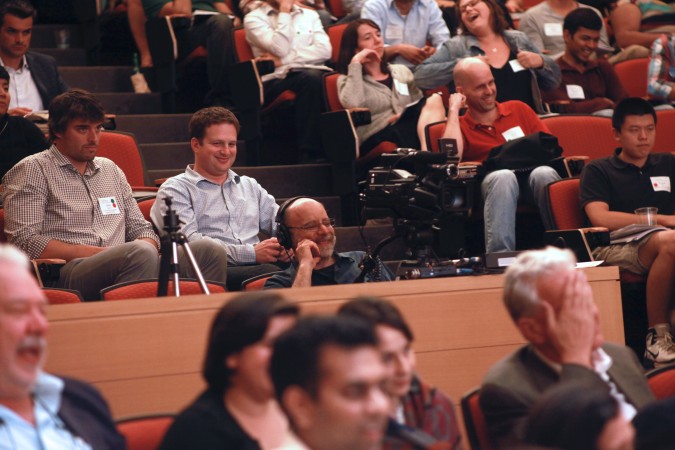
Stuart Sweetow, owner of Audio Video Consultants, capturing video at the Berkeley Entrepreneurs Forum, August 30, 2012
Vivek Mehra
August Capital
Vivek joined August Capital in 2003. He invests broadly in IT infrastructure and areas of interest include data center technologies, systems management, security, storage, and cloud computing systems and software. Prior to joining August Capital, Vivek co-founded Cobalt Networks in 1996. As CTO & VP of Product Development, Vivek built the first successful server appliance and grew Cobalt into a worldwide leader in the category, culminating in a successful IPO and acquisition by Sun Microsystems for $2B. At Sun, Vivek served as the Vice President and General Manager of the Cobalt Business Unit and a member of Sun’s Technical Architecture Council. Prior to founding Cobalt, Vivek held a number of technical and management positions at Apple, SGI, and Digital Equipment Corporation and successfully developed numerous products including Internet enabled set-top boxes, PDAs, RISC workstations, and high performance graphics subsystems.
Vivek received a BS in Electronics from Punjab University, India, and an MS in Computer Engineering from Iowa State University.
To my knowledge, I have been attending The Berkeley Entrepreneurs Forum for longer than anyone else besides Jerry Engel, who founded The Lester Center in 1991 and was its Executive Director for nearly two decades.
I have some suggestions to improve the The Entrepreneurs Forum, which I will describe here. I am posting these suggestions publicly because they are likely applicable to numerous programs across the globe, and I’d like to see these ideas adopted widely if people think they are worthwhile.
1. Dispense with the table panelists sit at. The table doesn’t look good on camera or video, and over time the majority audience for the Forum should be watching online, since the rooms frequently sell out already. Panelists should sit on arm chairs or couches, like they do at most tech conferences that I attend. The moderator should sit with the panelists and not be off to the side standing at a podium. All the people on stage should be outfitted with wireless lapel microphones. I would like the Forum to appear more conversational in style. The table separates the speakers from the audience, where arm chairs suggest a residence for a more intimate vibe.
Here’s an example of a more visually appealing way to run a panel. Steve Bengston is the moderator for this panel at The Churchill Club, where he is a member of its Board of Directors and its past Chair.
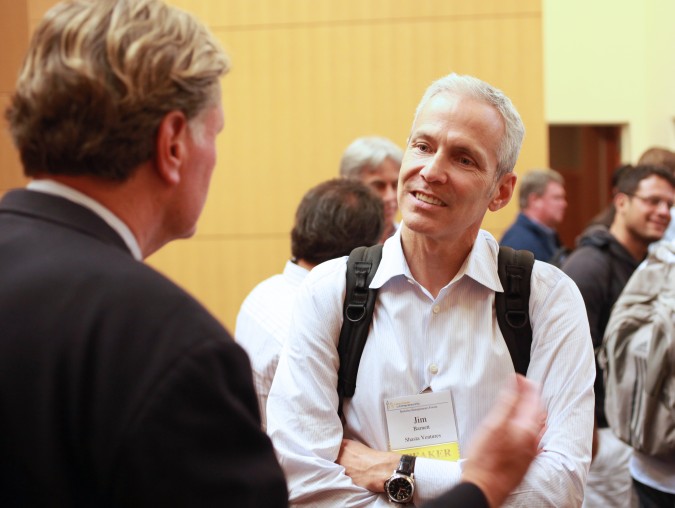
Jeff Burton, the brand new Executive Director of the UC Berkeley Skydeck, talks with Jim Barnett of Shasta Ventures, August 30, 2012
2. Commercial bottled water should be forbidden on stage, even if the speakers bring it with them. Nearly all the conferences I attend serve water from pitchers into real glasses. Bottled water is an evil product, and it looks bad in photographs and video to see those bottles. Image is important, and promoting bottled water by showing it on stage should stop.
3. Commercial bottled water should not be a beverage choice during the networking hour. Tap water should be offered, and it should not require a drink ticket.
4. When it comes time for audience questions, invite the questioner to sit on stage in an arm chair or on the couch while they ask the question and while they are receiving the answer. This will give the questioner time on video, and will permit them to look the speakers in the eye. This will be a treat for the audience members, because they’ll feel they get to ‘meet’ the panelists for 60 or 120 seconds. Questioners can line up to get their turn on stage. Questioners should be encouraged to state their first and last name, so they can be identified online.
5. Although I appreciate that it’s a lot of work, the Forums should be transcribed, and the transcribed text should be posted online. This is a certain way to get more traffic to The Lester Center website, and it’s likely to increase the interest in the Forum from attendees that can’t attend in person.
6. All Forums should be archived online, including Forums from ten and twenty years ago. Forums should never expire and be removed.
7. The ‘numbers’ should be videotaped and included in the online video. The numbers are often the most interesting part of the evening. The contact information for the number presenters should be posted online, with permission of course, and there should be a hyperlink to the project the person is working on.
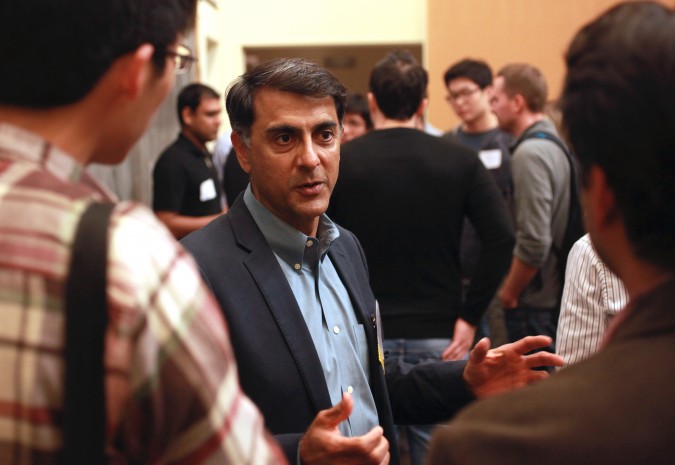
Vivek Mehra, a partner at August Capital, answers questions posed by attendees at the Berkeley Entrepreneurs Forum, August 30, 2012
8. The photographs taken by Bruce Cook, the official photographer, should be publicly posted to Facebook, and should be tagged. Once the identities of the people pictured are known via the tagging, the captions for the official Lester Center website should be updated to identify everyone whose name is known. If required, change the terms of the tickets purchased to give UC Berkeley the right to identify the people by name. Offer an ‘opt out’ list during checkin. Having the names with the pictures will increase traffic to The Lester Center website, since people will search for those names for decades to come. Invite people to tag the pictures in the emails The Lester Center sends out and via Facebook status updates.
9. A vast collection of at least 5,000 of Bruce Cook’s unpublished photographs of the Forum from the last twenty years should be published to Facebook and the Web, and they should be tagged and captioned. This was entirely my idea — Cook did not hint that I propose such an idea. The majority of the pictures published should be of the networking hour, to get as many people from the audiences over the years tagged as possible.
10. The Forum should be oversold, like airplane seats. This August 30th Forum was ‘sold out’ but there were unfilled seats in the auditorium, which takes away from the excitement of a sold out show. If too many people show up, they can watch on video monitors in the Bank of America Forum, and as compensation for not getting a seat, their entrance fee can be 100% refunded. I predict the revenue over time from overbooking will more than make up for the refunds that need to be given. Attendees should be told when they buy their tickets they risk being bumped, and encouraged to arrive early to be sure they get a seat.
11. The reminder to ‘Like’ The Lester Center on Facebook should be repeated on a poster displayed during the Forum. The Forum’s Twitter handle should also be on this poster.
12. Attendees should be given a perk if they follow the Forum on social networks, such as a second drink ticket on their next visit to the Forum, to encourage getting as many followers as possible. Currently attendees may eat unlimited quantities of food at the Forum, but are permitted only one drink, either with alcohol or without.
13. Attendees should be invited to blog and post about the Forums, and The Lester Center site should find and link to the best examples of such efforts, to encourage people to write about the Forum.
I am one of the only bloggers writing about the Forum, but there should be at least several.
14. I love the luxurious food served during the networking hour, but it sure seems like it must cost a fortune. I think it would be more than fine to switch to less fancy food. There is precedent for this. Last year at the Founder School Demo Day what appeared to be inexpensive sandwiches were served, but the event was superb and not diminished by the more everyday food. I suspect the food budget for the Forum could be cut by two thirds without getting more than a handful of complaints. The Forum is still too expensive at USD $25 a ticket, and I bet it loses money even at that price. When I started attending in my mid twenties, the cost was prohibitive. It was only due to my getting free tickets from my employer at the time, Cooley, that I attended regularly. The goal should be to get lots of currently poor entrepreneurs in the making to attend, including but not limited to Berkeley students.
I suggest the price should be no more than $10. To get the price that low, I suggest alcohol should cost extra.
That is all my suggestions for now. The Forum is already a success, or I would not have attended for twenty years. I am trying to make the Forum better.
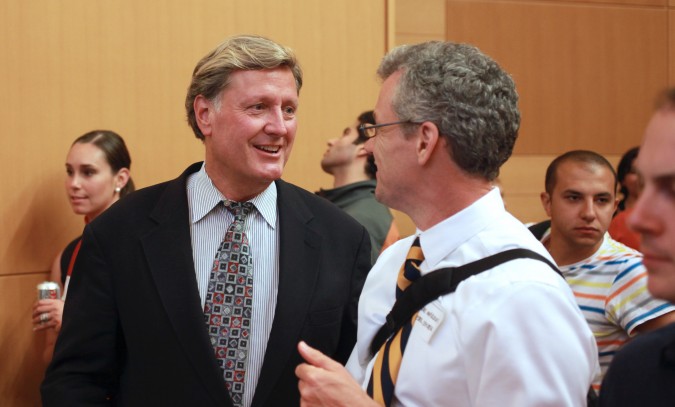
Jeff-Burton, left, the brand new Executive Director of the UC Berkeley Skydeck talks with Andre Marquis, Executive Director of The Lester Center for Entrepreneurship & Innovation, August 30, 2012. Photo by Kevin Warnock.
I upload pictures to this blog at the maximum resolution my camera produces — 21 megapixels. Click on them twice in delayed succession to see them at full size. I shot these pictures at ISO 4,000 due to the low lighting levels.
Click here to see all the posts I have written about the Berkeley Entrepreneurs Forum.
The law firm Fenwick & West LLP where Sam Angus is a partner produced and gave away a great 80 page booklet at the Forum. Retired Fenwick attorney Jacqueline Daunt wrote a fantastic introduction to startups that includes a capitalization table for a hypothetical company from pre-funding stage through a public stock offering. Thank you Fenwick! If I can post this booklet, please let me know and I’ll update this post with a link to a PDF scan of the booklet.
Finally, as an end note, I met Steve Bengston in 1999 during the first dot com boom, when he agreed to help me with Hotpaper, my startup at the time. It turned out I didn’t call on him much, since I lined up financing almost too easily, but I will never forget pitching him at his PriceWaterhouseCoopers office in San Jose, California USA, and him telling me at that meeting that he would help me. Bengston is well known, and I was thrilled to have his support, especially back then when I didn’t know many people or know much of anything.
Annual Andrew Fluegelman Awards Gala Honoring Outstanding Students, Student-Athletes & Foster Parents, May 18, 2012
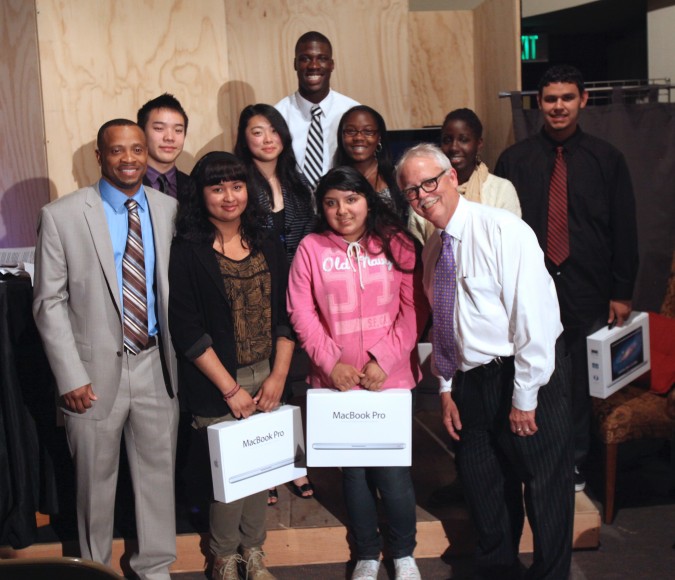
Winners of 2012 Andrew Fluegelman Foundation Fellowship Awards showing off their new Apple MacBook Pro laptop computers, May 18, 2012. Bruce Bouligny on left and David Bunnell in white shirt.
On Friday, May 18, 2012, the day of the Facebook Initial Public Offering of stock, I attended the annual Andrew Fluegelman Foundation Fellowship Awards Gala, held at the Linen Life Gallery at 770 East 14th Street, San Leandro, California USA. Here is the Facebook page for the Andrew Fluegelman Foundation. Bruce Bouligny is the Director of the Fluegelman Foundation.
I learned of this event the morning of the event, thanks to a Facebook status update from Harry McCracken, Editor-at-large at Time Magazine. McCracken encouraged his Facebook subscribers, of which I am one, to attend this event. McCracken also linked to a piece he wrote for Time entitled Remembering Andrew Fluegelman, a Quiet Giant of the PC Revolution that introduced me to Andrew Fluegelman, a man I had not previously heard of. Once I read McCracken’s piece on Fluegelman, I got a ticket for the Awards Gala and attended as a blogger. Amazingly, the tickets were free, although they did ask for a modest donation at the door, which I happily made.
Andrew Fluegelman disappeared in 1986, and it’s assumed he committed suicide by jumping from the Golden Gate Bridge. He was 42, and his body was never found.
I had only been at the Linen Life Gallery for mere minutes when my friend Stuart Sweetow came over to say hello. I recognized him but couldn’t place him, as I only see Sweetow at the Berkeley Entrepreneurs Forum at The Lester Center for Entrepreneurship and Innovation at the Haas School of Business at the University of California at Berkeley. He’s the videographer for the forums, and has been for some 15 years. I have had the privilege of appearing in one of Sweetow’s videos that he created for the Forum.
Sweetow absolutely made my evening.
How so? It turns out that Sweetow runs a business called Audio Visual Consultants. He’s been in business since 1983 — impressive. In 1986 he was hired by PC World, which Fluegelman co-founded with David Bunnell, to produce a video tribute to Andrew Fluegelman.
A few weeks ago, Sweetow was moving his company’s office and studio to new space and he stumbled upon the ancient video cassette he had produced decades earlier. He decided to call David Bunnell, the co-founder of the Andrew Fluegelman Foundation (and PC World Magazine), to ask if he wanted the tape. Bunnell was probably stunned to get Sweetow’s call. The copy PC World received decades ago had been lost. It was thought that it would never resurface. Thanks to Sweetow, the Foundation and presumably PC World has the video again, and it’s been posted to YouTube so a wider audience can view it.
What a heartwarming story. Here’s Sweetow’s video:
I asked Sweetow if I could blog about this story, and he said that I may.
Sweetow then pointed out that David Bunnell was standing near us. Sweetow offered to introduce me, and I accepted.
David Bunnell co-founded PC World Magazine with Andrew Fluegelman. I used to read PC World frequently. Before the Internet, such magazines were required reading for those interested in technology. You read such magazines the way we read websites like TechCrunch and Engadget today. I got to meet a publishing legend Friday night.
Happily, PC World is still in business, with a vibrant online presence in addition to the physical editions of the magazine.
I asked David Bunnell if I could photograph him, and not only did he agree, but volunteered to step outside into the still bright daylight so I could get a well lit portrait of him. Had he not volunteered, I would have directed him outside, as the light there was perfect. The pictures of Bunnell are at the bottom of this post.
I used my Canon 5D Mark II for these photographs, and I uploaded them at full 21 megapixel resolution. Click on the pictures to see them at full size.
Here is what David Bunnell wrote for the official paper program distributed at the event:
“Andrew Fluegelman (1942-1985)
During his brief life, Andrew made major contributions to the booming computer revolution. In addition to co-founding PC World and Macworld magazines, he wrote PC-Talk, the software program that for the first time made it possible for personal computers to exchange data over a phone line.
Believing that PC-Talk should be available to as many people as possible, Andrew came up with the novel idea of simply giving it away and asking people to send in a donation if they liked the program.
Andrew called this method of distributing software, “freeware.” Thousands of other programmers started making their software available this way, which helped the PC industry grow even faster.
Underlying Andrew’s work was his profound belief that personal computers have the power to transform anyone’s life. Whatever a person’s background and circumstance, if they had a computer their lives could be dramatically changed for the better.
With the help of some of Andrew’s other friends, I established the Andrew Fluegelman Foundation to keep his memory alive and to realize his vision that computers can make a dramatic difference.
Working with other nonprofit organizations, we identify outstanding high school seniors who have overcome the challenges of growing up in poor neighborhoods and who have been accepted into university, college or other advanced educational program. They also must demonstrate a desire to “give back” to their communities.
In Andrew’s name, we give these students a Macintosh laptop computer, printer and training in the use of Google applications, courtesy of Google.
So far, all the students who have won Fluegelman Fellowships have gone on to be successful in college. They arepot to us that owning their own Macintosh computers has been a huge part of that success.
I truly believe Andrew would have loved this program, and that his spirit is with us tonight.
–David Bunnell”
Fluegelman in 1982 created PC-Talk, the first dialup communications program for IBM Personal Computers and their clones. Back then, computers were connected via standard wired telephones directly to each other, not by going through central servers run by companies like AOL, Compuserve or Prodigy. Fluegelman distributed PC-Talk at no charge, and encouraged people to copy it and give it to friends. He made money by asking but not requiring that people mail him money via postal mail. He suggested donations of USD $25 and later more. That was a fair amount of money back then. I suspect it still works today, at least on Windows XP.
Fluegelman was the first Editor-in-Chief of PC World magazine. He interviewed Bill Gates in 1984, as shown in this picture from the Fluegelman Foundation’s Facebook page:

Andrew Fluegelman, on the far right, interviewing Bill Gates, standing, in 1984. Photographer unknown.
The Fluegelman Foundation honors Andrew Fluegelman’s memory by awarding Apple MacBook Pro computers to seven deserving high school seniors each year. Fluegelman believed that a computer could change a person’s life, so he would have approved of the work this foundation is doing.
This year Apple MacBooks were awarded to:
- Daniel Rodriguez – Castlemont High School
- Teresa Unique Cole – MetWest High School
- Andranee Nabors – Berkeley High School
- Cara He – Skyline High School
- Rocio Montes – Skyline High School
- Brian Lien – Skyline High School
David Bunnell and Bruce Bouligny took turns reading portions of the winning essays these winners submitted to compete for the laptops. The students were not given a chance at the microphone to say ‘thank you.’ I suspect this was the first time these students had been on stage outside of school. In future years, I suggest the organizers allow each student 60 seconds at the microphone to say thank you. They should be told of this opportunity in advance so they can prepare and practice their remarks. They will likely be nervous, but it should be a condition of winning that they say something. It will be a valuable learning experience to speak before strangers, and it’s one they won’t likely ever forget. The audience I am sure would welcome hearing from the students.
I tried hard to get permission to photograph the winners individually like I was able to photograph David Bunnell and Larry Magid, below. But I didn’t ask soon enough and the time simply ran out. I would have loved the chance to spend two minutes with each student properly photographing them. If I attend next year, I will prepare in advance with the organizers so that I can do this.
The Fluegelman Foundation also gives awards to an outstanding foster parent each year. I did not learn how this award is connected to Fluegelman, and there may be no overt connection. Whether there is or not isn’t important. The evening was an inspiring delight, and I am so glad that I attended.
Two foster parents spoke.
The first foster parent to speak was Tracy Beckham, who has 12 children. Eleven she and her husband adopted after doctors told her they would not be able to conceive and carry to term a biological child. We learned that their youngest child, the girl in the white dress below, is their biological child, and she was conceived naturally with no assistance from the fertility industry. Beckham told us how doctors at first thought she was sick, but eventually concluded she was pregnant. What a happy surprise.

Tracy Beckham with her family plus a few others, May 18, 2012 at Andrew Fluegelman Fellowship Awards Gala. Photo by Kevin Warnock.
Beckham’s 6’6″ son Dorial Green-Beckham, the tallest in the two shots immediately above and below, is already famous, with his own entry in WikiPediA, I learned. The pictures I took of him are likely to get this blog some significant traffic. Thank you Dorial and thank you to his mother Tracy, who gave me permission.
Dorial is a famous high school football player. According to The Columbian Missourian newspaper, Dorian was the most recruited high school football player in the United States in 2012. Here’s a long piece that details how intense this process was.
Dorial signed with the Missouri Mizzou Tigers, after a courtship that lasted years. I had no idea before today that even happened. I don’t follow football, and I only occasionally watch the Super Bowl.
I had never heard of Dorial before this event. I am glad that I met him, and he was gracious and patient as I set up the pictures you see here. I gave him posing directions just like I give the female models I photograph. I wonder what he thought of me given that he’s probably been photographed by hundreds and hundreds of photographers to date.
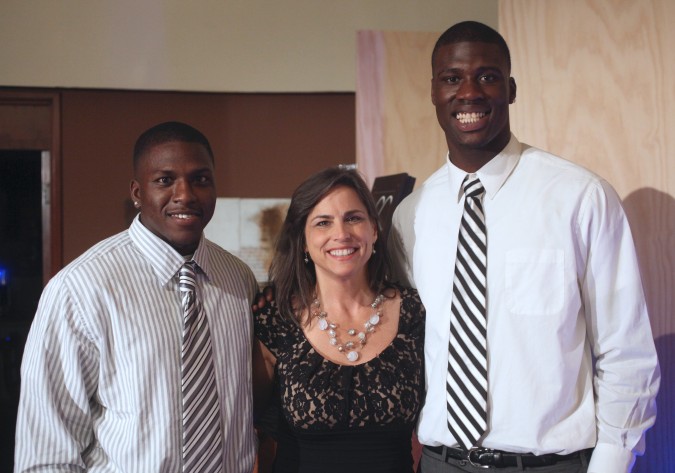
Tracy Beckham with 2 of her 12 children including Dorial Green-Beckham on the right. May 18, 2012 in San Leandro, California. Photo by Kevin Warnock.
Have a look at this YouTube video that shows Dorial breaking the United States national receiving record for high school football.
Here’s a clip of Dorial catching a 79 yard pass with one hand during the 2012 Army All American Game. Looks impressive to me:
Dorial Green-Beckham was awarded the first National Fellowship awarded by the Fluegelman Foundation, and Dorian was given an opportunity to speak to the audience, which he accepted.
The second foster parent to speak was Athaline Burns, shown in the photograph below holding her award plaque for East Bay Foster Parent of the Year.
Burns told the crowd she provided care to about 100 foster children that lived in her home over the years. This is an astonishing and important contribution to society. Burns kept her remarks short, so I don’t have any stories to relate about her remarkable life. I didn’t have the opportunity to talk with her after the event, which I regret. I would like to interview her for this blog at some point, and meet her family to hear about their experiences first hand. I have at times considered becoming a foster parent, so I have more than a casual interest in this subject.
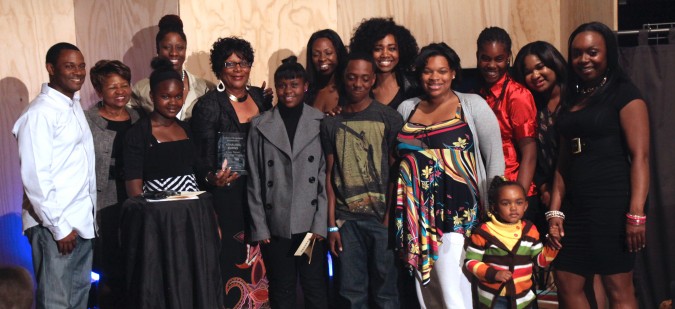
Athaline Burns, holding award plaque, shown with her family. Burns is East Bay Foster Parent of the Year. May 18, 2012 in San Leandro, California. Photograph by Kevin Warnock.
Here is the portrait that I took of David Bunnell and Larry Magid together:
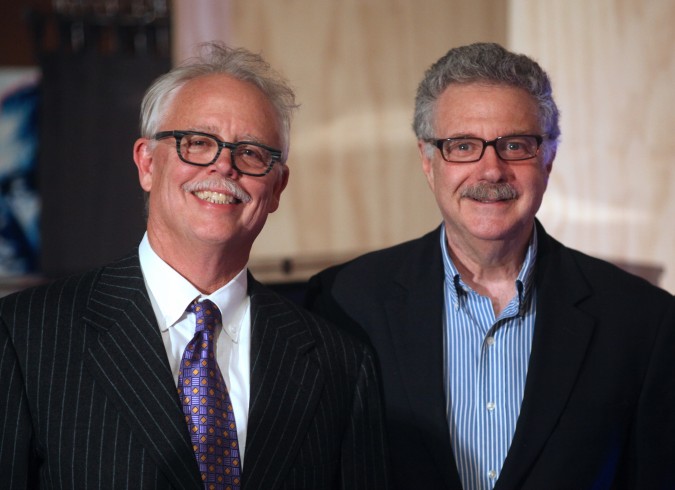
David Bunnell and Larry Magid, May 18, 2012 at Andrew Fluegelman Foundation Fellowship Awards Gala in San Leandro, California. Photo by Kevin Warnock.
Bunnell and Magid provided commentary at the start of the event about the storied life of Andrew Fluegelman. I got the distinct impression that both Bunnell and Magid are elder statesmen in the technology industry, so I am so grateful that I got to photograph them together and separately, and that the results were so pleasing. Magid asked if he could use the results, and I happily told him that he may. Of course, Bunnell may as well, as well as all the others that I photographed. I am very flattered when I encounter my photographs around the web and on other peoples’ Facebook pages. Twenty four of my Facebook friends are also friends with Magid.
Larry Magid is Co-Director of ConnectSafely, a non-profit. Magid provided Gala attendees with free copies of the book A Parent’s Guide to Facebook (also published in Arabic). I have a copy, and from reading part of it I can say it’s well written and likely to be very valuable to parents. I’ve never seen such a lushly produced guide to safely using potentially a potentially dangerous site like Facebook. I plan to read the entire book. Here’s an abstract of what ConnectSafely is about, from the group’s website:
“ConnectSafely is for parents, teens, educators, advocates – everyone engaged in and interested in the impact of the social Web. The user-driven, all-media, multi-platform, fixed and mobile social Web is a big part of young people’s lives, and this is the central space – linked to from social networks across the Web – for learning about safe, civil use of Web 2.0 together. Our forum is also designed to give teens and parents a voice in the public discussion about youth online safety begun back in the ’90s. ConnectSafely also has all kinds of social-media safety tips for teens and parents, the latest youth-tech news, and many other resources.
ConnectSafely.org is a project of Tech Parenting Group, a 501(c)3 nonprofit organization based in Palo Alto, Calif., and Salt Lake City, Utah. The forum is co-directed by Larry Magid of SafeKids.com and Anne Collier of NetFamilyNews.org, co-authors of MySpace Unraveled: What It Is and How to Use It Safely. (Peachpit Press, Berkeley, Calif., July 2006).”
Larry Magid is also the on-air technology analyst for CBS. Magid has over 62,000 subscribers on Facebook.
Here is the portrait that I took of David Bunnell:
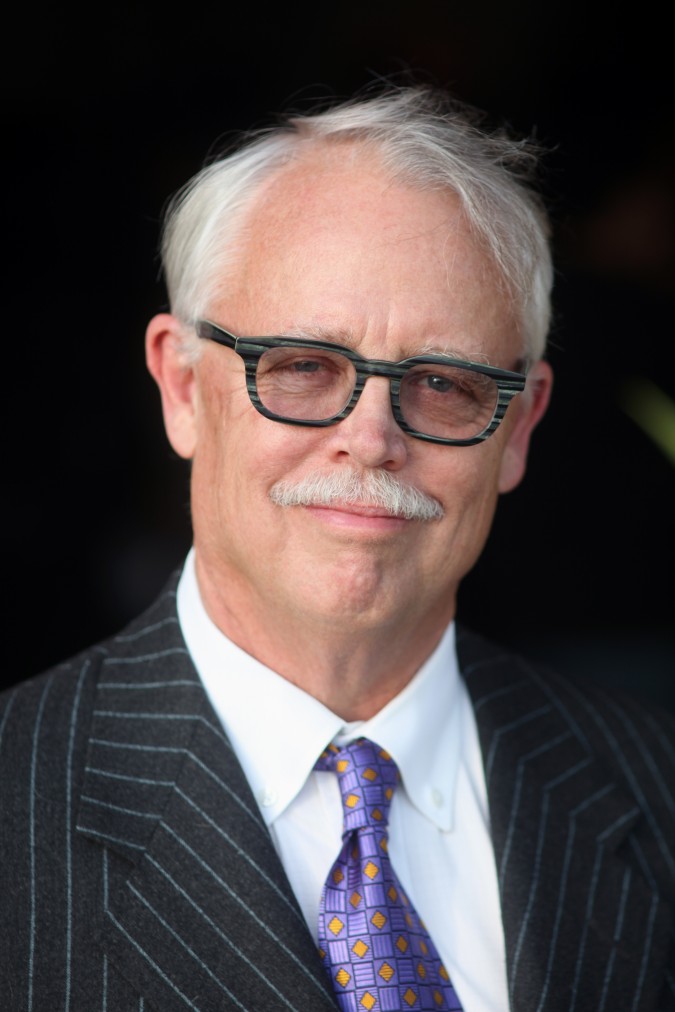
David Bunnell, co-founder of Andrew Fluegelman Foundation, May 18, 2012. Photographed by Kevin Warnock.
Here is the portrait that I took of Larry Magid:

Larry Magid, on-air technology analyst for CBS, photographed May 18, 2012 at the Andrew Fluegelman Foundation Fellowship Awards Gala. Photo by Kevin Warnock.
Here is a photograph of the reception prior to the awards ceremony. The food and drink were outstanding, thanks to B Restaurant and Bar, Trader Joe’s, Markham Vineyards, Carl Talaue Catering, RSVP Catering and T-Rex BBQ.
The Skyline Jazz Band, made of up musicians from Skyline High School, played during the reception. The band’s director is Vincent Tolliver. The musicians are:
- Olivia Ports – Drums
- Ella Pearson – Piano
- David McMillan – Guitar
- Zach Seidl – Bass
- Jeff Seidl – Trombone
- Jeramy Kaetzel – Trumpet
- Andrew Wong-Rolle – Alto Saxiphone
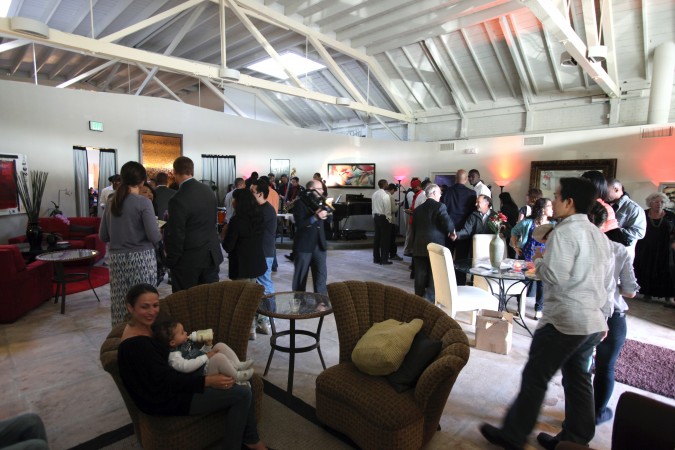
Reception at 2012 Andrew Fluegelman Foundation Awards Gala in San Leandro, California, May 18, 2012. That's Stuart Sweetow in the center holding the video camera.
Charleston Pierce was the Master of Ceremony. I found him vibrant, charismatic and engaging. He said he’s a graduate of San Francisco School of the Arts, or SOTA. This school is located in the same building where I went to high school. That school, J. Eugene McAteer High School, was dissolved in 2002 due to its being atrocious, which I can personally confirm.
SOTA seems to be churning out winners, like Devon Ivie, Havel Weidner and Cristina Rey, all of whom I met in February, 2012 at the San Francisco Mock Trials citywide finals. They were on the student team representing SOTA, which this year competed with Lowell High School, generally thought to be the best public high school in San Francisco. SOTA lost to Lowell this year, but has won over Lowell multiple times in past years. The students I met in February are very polished and impressive, and I predict they will go far in life, unlike most of my McAteer classmates, I am sad to report.
I got to shake Pierce’s hand, but sadly didn’t get to interview him. He’s in the entertainment industry, and I bet he’s somebody my readers would love to learn more about. If he’s reading this, I invite him to contact me to schedule an interview.
Congratulations to all the winners at the 2012 Andrew Fluegelman Foundation Fellowship Awards. To the student winners, I say study hard in college, drink alcohol very moderately or not at all, decline all illegal substances and activities, keep in touch with your professors long after you graduate, and start building and nurturing your personal brand right now, by blogging and Tweeting thoughtfully, articulately and responsibly.
When you graduate, future employers will then have four years (decline the five year program!!!) of your posts to read to get a sense of who you are and why they should hire you. You’ll be far ahead of most of your peers, even your peers that might have better academic credentials than you have earned. In life it’s not just grades, but your character, passion and drive that will advance you past your peers. You can start today with WordPress and your shiny new Macbooks. Good luck, and drop me a line once a year to let me know how your MacBook enhanced lives are going. I will write about you here if you take me up on this.
College will be over in two snaps of your fingers, so relish it, embrace it and blog about it! Have fun.
———-
May 21, 2012 – I added a photo credit to the caption under photograph of Stuart Sweetow, which was taken by Rufus Diamant.
2012 Berkeley Startup Competition Finals at University of California Berkeley
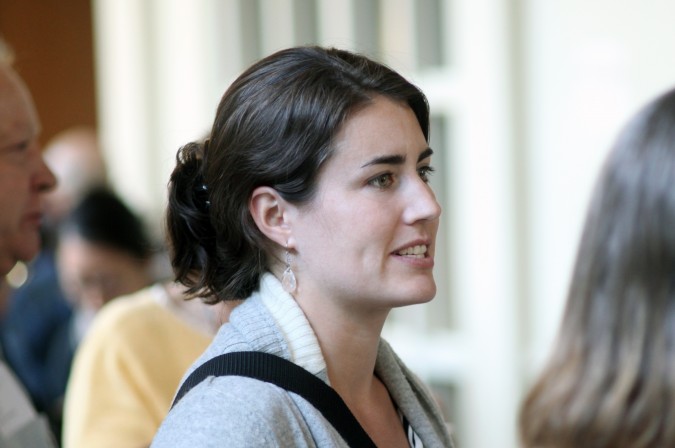
Kate Garrett, co-founder of Calcula Technologies, Grand Prize winner of the 2012 Berkeley Startup Competition, April 26, 2012
On Thursday, April 26, 2012, I attended the Berkeley Startup Competition Final Awards Ceremony at the Anderson Auditorium on the campus of The Haas School of Business at the University of California at Berkeley. Here is the PDF format file of the 2012 Berkeley Startup Competition Final Awards Ceremony program booklet that was handed out at the final awards ceremony.
There are many people mentioned in the booklet, like the Co-Chairs for the 2012 competition, Nick Nascioli, Adam Sterling and Tom VanLangen, as well as Lester Center Executive Director Andre Marquis and Haas School of Business Dean Richard Lyons.

Grand Prize winner Calcula Technologies at the Berkeley Startup Competition, April 26, 2012. Left to right: Nick Mascioli (co-chair of the Competition), Adam Sterling (co-chair of the Competition), Kate Garrett, Dan Azagury, David Gal, Buzz Bonneau, Tom VanLangen (co-chair of the Competition)
I most recently wrote about the announcement of the finalists for this competition, which happened two days earlier, on April 24, 2012.
Calcula Technologies won the Grand Prize and the Life Sciences Track for their clever system that vacuums kidney stones out of a patient’s urethra in just ten seconds. According to the team’s presentation, doctors today let stones pass from the body naturally and often quite painfully unless they are larger than 10mm in diameter. Patients today are often in such agony that they visit the emergency room, which racks up hundreds of millions of dollars in charges per year. For the sub 10mm stones, doctors just write prescriptions for narcotic pain killers and send the patients home with the stones still on their excruciating slow path out.
In the future, when and if Calcula gets their system approved by regulators, patients could have a catheter inserted into their urethra and the stone could be sucked out in seconds, presumably at great relief to the patient. This work could be done at the office of a urologist, without surgery, and the Calcula team said there is already a prized and lucrative reimbursement code in existence in the insurance industry, so if they build this system, they will be able to get paid and make a profit. I can understand why Calcula Technologies won the grand prize. Kidney stones are no fun, I’ve heard, and this system seems very appealing. The team showed a video of a fake kidney stone being sucked out of a pig’s urethra in just 10 seconds. It was very impressive and very memorable.
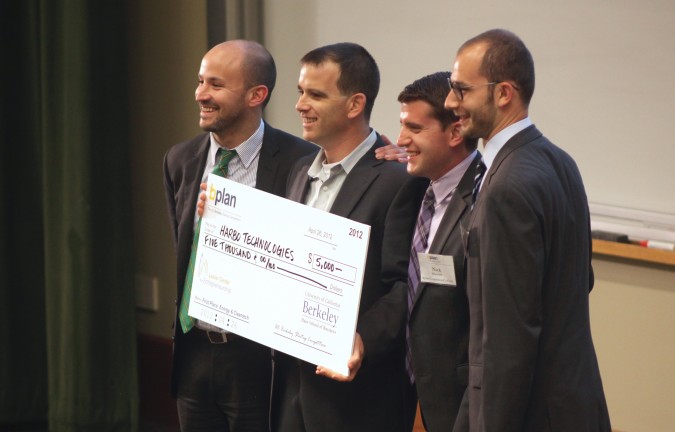
First Place Energy and Cleantech winner Harbo Technologies at the Berkeley Startup Competition, April 26, 2012
Kloudless, Inc. won first place in the Information Technologies and Web Track. I am going to be interviewing Kloudless, so I’ll save my remarks for another blog post.
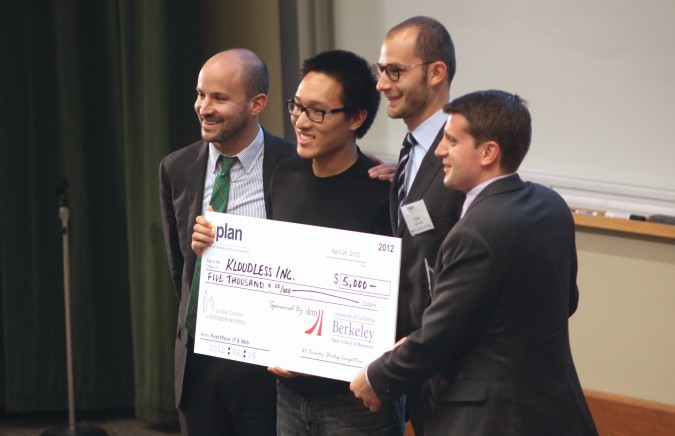
First place IT and Web Track winner Kloudless, Inc. at the Berkeley Startup Competition, April 26, 2012
Like Calcula, Back to the Roots (2935 Adeline Street, Oakland California 94608 USA) won two awards. First, they won the Products and Services Track, and then, thanks to real time votes from the audience and viewers of a live stream on the Internet, they won the Peoples’ Choice Award.
I have written about Back to the Roots twice before.
I have one of their products at my house right now. It works.
Back to the Roots collects used coffee grounds from coffee houses like Peet’s Coffee and mixes it with a ‘secret sauce.’ The combination is boxed up and sold at over 1,000 stores in the United States, including at Home Depot and Whole Foods Market. A consumer buys the cardboard box and partly opens it, exposing the insides. The consumer then mists the contents of the box with water using an included spray bottle. After ten days of twice daily misting, the consumer harvests a bountiful crop of oyster mushrooms that have grown directly out of the side of the box. Once one side has been used up, the consumer opens the other side to repeat the growing cycle for a second harvest.
That story has been told thousands of times, including on the CBS Evening News, an influential national newscast in the United States.
During their public presentation, the Back to the Roots team disclosed future plans that I find fascinating. Since this event was public and was streamed live to the Internet, I feel that it’s OK to write about what I learned, as there were no statements that anything said was to be considered secret.
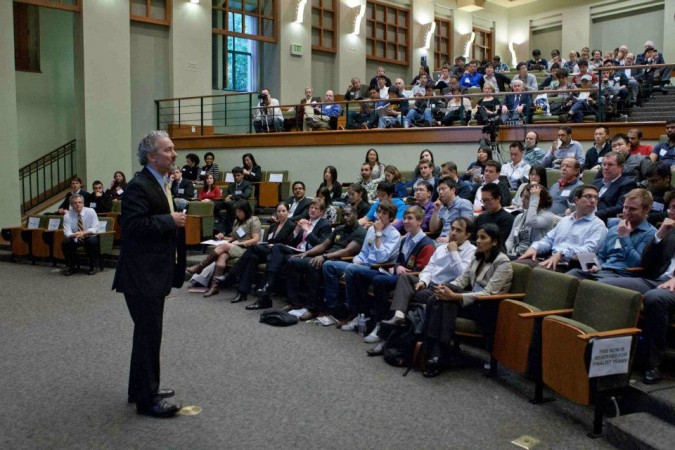
Haas School of Business Dean Richard Lyons speaks at the Berkeley Startup Competition Finals, April 26, 2012. Photograph by Bruce Cook.
The box contents will soon include vegetable plant seeds, and the rest of the box and liner will be biodegradable. Currently, the box is lined with what looks like conventional plastic. My box is from November, 2011, so things today may be different. In the future, or perhaps even already, the box will be lined with either nothing or something else that’s biodegradable. Perhaps what looks like conventional plastic to me is really biodegradable plastic, like some plastic trash bags are made of.

Venture capitalist Michael Berolzheimer, of Bee Partners, attends the Berkeley Startup Competition, April 26, 2012. Berolzheimer also leads the Haas Founders group that I am a member of.
Why do this?
Once the box is biodegradable and contains vegetable seeds, that means that after the two mushroom harvests the box can be planted in dirt for ’round three’ of production — vegetables. The mushrooms came from the waste stream from coffee houses. The round three vegetable garden will come from the waste stream of the mushroom garden.
This is beautiful.
What’s coming down the road from Back to the Roots?
I am overjoyed to report the answer may be affordable aquaponics kits.
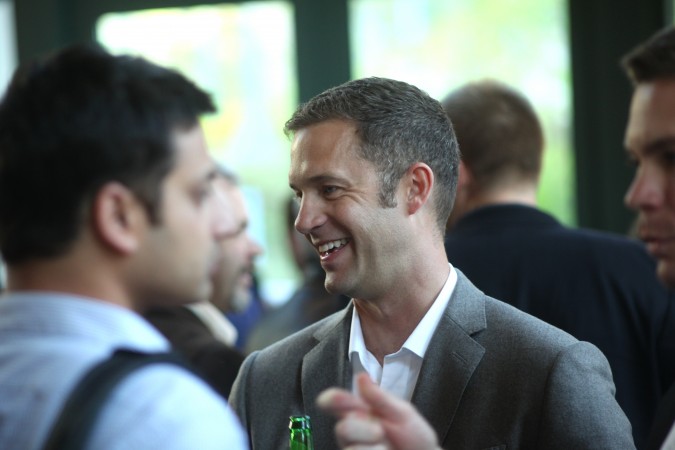
Kevin Esse at networking hour prior to attending Berkeley Startup Competition Finals, April 26, 2012
I have written before about my love for aquaponics.
Aquaponics is food production gardening enhanced by growing edible fish in symbiosis with vegetable plants. Both parts of the system are made more productive by the presence of the other half. Fish poop gets converted by bacteria into rich fertilizer. The fish grow faster because the plants keep the fish tank cleaner. It’s a great growing system that I feel should take over the world on such a scale that every person has their own system at home.
I am too busy in life to advance this dream, but the team at Back to the Roots has time and energy and market traction, so I think they would be ideal to push aquaponics to a large audience. I am so excited about this that I have already offered to tell the company everything I know about aquaponics free of charge to encourage them to get this to market.
I suspect they plan to start with small, under USD $100 demonstration kits. This in my mind is the way to start.
I bought my startup supplies for my aquaponics system from The Aquaponics Source. This online retailer sells complete systems, but the price is too high for people to buy casually, at over USD $1,000. I believe a profitable sub $100 kit could be sold, as what’s required is similar to what’s inside a Mr. Coffee brand coffee maker — two water containers, a pump, a heater and some electronics to coordinate the steps. I can get a nice computerized Mr. Coffee coffee maker for about USD $25 from Amazon, so even in the smaller quantities a demonstration aquaponics system would sell in initially, I think it can be done.
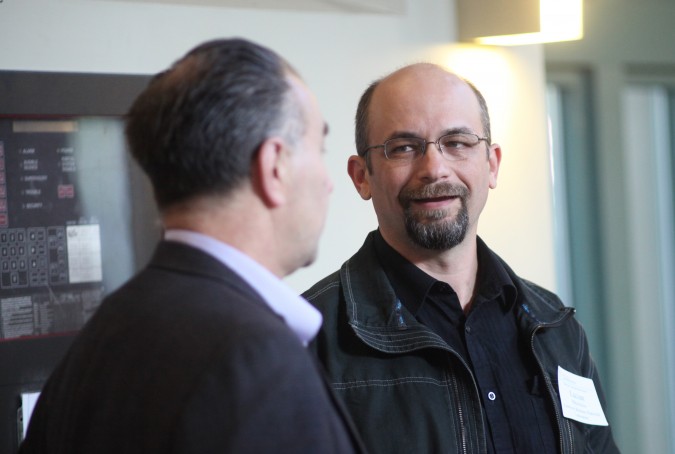
Lucian Mihailescu of Lawrence Berkeley National Laboratory attends the Berkeley Startup Competition, April 26, 2012
I love advising startup companies, and I would particularly like to advise about aquaponics, even though I know relatively little about the subject, since I’ve only built one demonstration system so far. My system was a modest success for I grew the largest and sweetest tomatoes I have ever eaten.
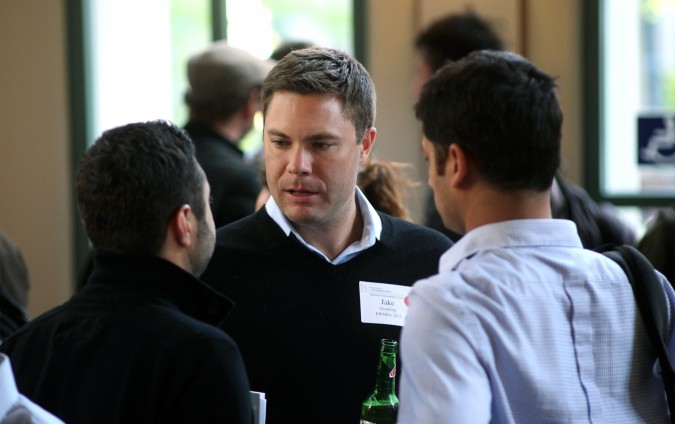
Jake Gentling at the networking hour prior to attending the Berkeley Startup Competition Finals, April 26, 2012
HARBO Technologies won First Place in the Energy and Cleantech track. I introduced myself to co-founder Boaz Ur and mentor John Matthesen after the conclusion of the event. The company is working on something I find impressive and interesting. I have made arrangements to interview the team, so I will hold my remarks until after that interview.
My friends at Modify Industries took home a USD $1,000 prize for coming in second place in the Products and Services Track. This outcome was inevitable, and I predicted it accurately the moment I saw Modify was competing with Back to the Roots. Back to the Roots simply has had much more commercial success so far. While Modify has sold between 10,000 and 100,000 watches to such companies as Google and Hewlett Packard, they haven’t yet cracked the retail store market, and they haven’t been on the evening television news. It’s rare for a company to be so far along like Back to the Roots, but still be eligible to compete in the Berkeley Startup Competition. In all other years where there was a Products and Services Track, Modify probably would have won that track. I pay attention to these things because I was a judge for this competition for the eight years through 2011. This year I mentored the team University Gateway, which did not make it to the finals since Modify and Back to the Roots filled up the Products and Services Track.
Modify gave an impressive and bold presentation, where they outlined a dream for their enterprise far bigger than time pieces. They probably adjusted their pitch to compete with Back to the Roots. But they forgot to show their product in action amid all the grand dream spinning. How so? They forgot to personally show the audience how to change a watch element from one silicone strap to another. This is worth showing at every pitch for it’s compelling and like nothing I’ve seen in the watch business. No tools, no training — 10 seconds and you have an all new look.
Finally, I want to give some space to my friend and fellow photographer Bruce Cook. I’ve known Cook since nearly the inception of The Lester Center for Entrepreneurship & Innovation. He’s a fixture at all sizable Lester Center events. He has his own photography business, Bruce Cook Photography, and is not a University of California employee. I can’t recall there ever being a different photographer for a Lester Center event. The picture above is of Cook standing under the video light in Anderson Auditorium. The picture below is of Cook taking a picture during the networking hour in the Bank of America Forum, the large gathering area just outside of the Anderson Auditorium. Cook took the picture above of Dean Lyons speaking to the audience. Thank you Bruce!
If The Lester Center is reading this, may I suggest that you contact Cook and work out a deal where his vast library of photographs of Lester Center events over the last twenty years can find a permanent home on the Lester Center website and in the University library system. Cook has photographed some of the most important figures of our time, and the tremendous majority, over 99%, of his photographs have not been published. I think these photographs should also be published on Facebook so that it’s easy to crowd source the identification of the people in the pictures, via the Facebook tagging system. Once the faces are tagged, then the captions on the Lester Center website can be updated to reflect the identities of those pictured.
Why do this?
The Lester Center and its events are documenting history. It’s that simple. Bruce Cook has a treasure trove of historic pictures that few have ever seen.
As an added bonus, publishing and captioning Cook’s 100,000+ pictures will boost traffic to The Lester Center’s website, as people search on Google and similar sites for the many luminaries Cook has photographed. The search engine optimization benefits to posting these pictures will probably overshadow every other single project you could undertake.
This is my idea alone.
Cook did not plant this, suggest this or hint at this.
I’ve been thinking about this for years now, and here seems like a fine place to promote the idea.
I believe I have shared this suggestion with Jerry Engel when he was Executive Director of The Lester Center, but that was only in passing at a hectic Berkeley Entrepreneurs Forum, not a written proposal such as this one.
Please consider this official advice, and let me know when I can blog about the happy news. Thank you.
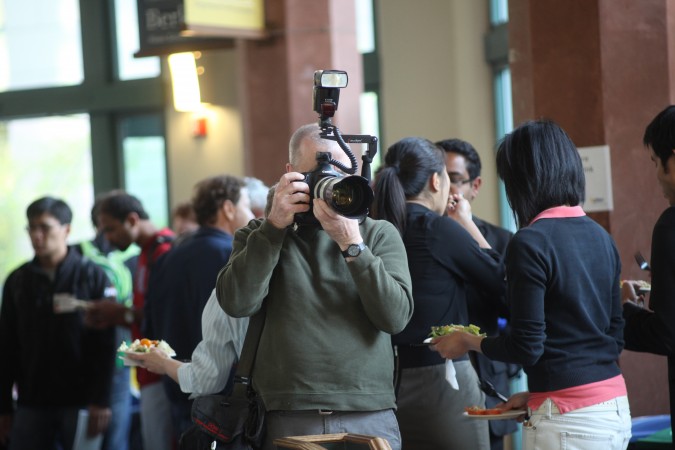
Bruce Cook, the photographer for The Lester Center events, covers the Berkeley Startup Competition, April 26, 2012
I introduced myself to all the finalist teams except AdrenaRX. I believe the members from that team departed before I had a chance to find them.
I offered each of the eight finalist teams except for Modify and Back to the Roots the opportunity to be interviewed by me for a future blog entry. Two of the teams have contacted me to schedule an interview. Four teams have not yet contacted me.
I know the Modify and Back to the Roots founders, so I did not offer to interview them. This was not meant as a snub — I simply forgot to offer in my excitement of congratulating them. Both teams are doing so well they don’t need my blog coverage, but if they would like more in depth stories, I am happy to meet with them. Just send me a message. I am on Facebook and easy to reach. I have turned on the ‘subscribe’ feature, so everyone reading this is invited to subscribe to me on Facebook. You may also sign up with your email address to receive updates to this blog, in the upper right corner of this page.
All the pictures I presented above except for the one by Bruce Cook are also on my Facebook page in this album. If you know these people, particularly the people in the shots with the giant checks, please tag them on Facebook so I can update the captions here with the names. All my pictures on Facebook are public, so if you tag someone there, I consider those names to be public, and on that basis I will update the captions here.
The sponsors for the 2012 Berkeley Startup Competition include:
Gold level:
Claremont Creek Ventures
DCM
UM
Silver level:
Javelin Venture Partners
Lowenstein Sandler
Mintz Levin
Mohr Davidow
Morgan Stanley
Morgenthaler Ventures
Morrison & Foerster LLP
Wilson Sonsini Goodrich & Rosati PC
Individual level:
There were possibly other individual sponsors. No individual level sponsors were listed in official materials this year, a departure from past years.
The Executive Committee for the 2012 Berkeley Startup Competition:
Co-Chairs
Nick Mascioli
Adam Sterling
Tom VanLangen
Judging & Sponsorship
Robbie Allan
Jane Buescher
Vivien Leong
Larry Pier
Marketing & Events
Stephanie Knoch
Krishna Shah
Mentorship & Events
Amara Aigbedion
Hrishikesh Desai
Program Manager
Kirsten Berzon
Berkeley Entrepreneurs Forum at Google, Inc. headquarters, October 27, 2011
Thursday October 27, 2011, I attended the first Berkeley Entrepreneurs Forum ever held away from the University of California at Berkeley campus.
The Forum was held in Building 40 at Google, Inc. headquarters in Mountain View, California USA. Getting to the event was a challenge because Google was throwing a huge celebration for the Indian national holiday Diwali. As a result, parking was tight and there were hundreds of people in the huge courtyard between the massive Google buildings. I’m not complaining for it was festive and an adventure. I photographed the 6,000 burning candles artfully arranged in the courtyard, as you can see at the bottom of this post. There was a live band. The Google cafeteria was packed. It was exciting.
The Entrepreneurs Forum was a small event compared to the outdoor Diwali celebration.
The title of the Forum was ‘Power Hungry: Developments in Energy-Efficiency Technologies for Data Centers.’ This was an appropriate event to have at Google, which I suspect runs the largest collection of computers in the world.
I learned a lot at this forum. For example, computer rooms that are chilly are computer rooms that are horribly inefficient. Modern servers can run fine at temperatures around 85F degrees, and sometimes even warmer. Here’s the official video, immediately above.
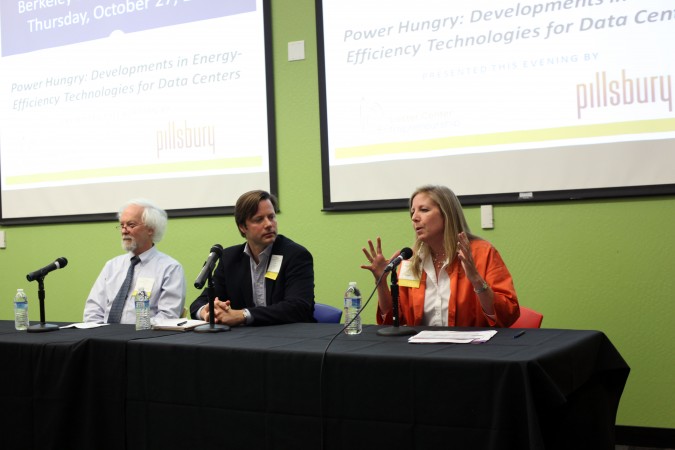
Dale Sartor, John Robison and Joyce Dickerson on panel at Berkeley Entrepreneurs Forum, October 27, 2011
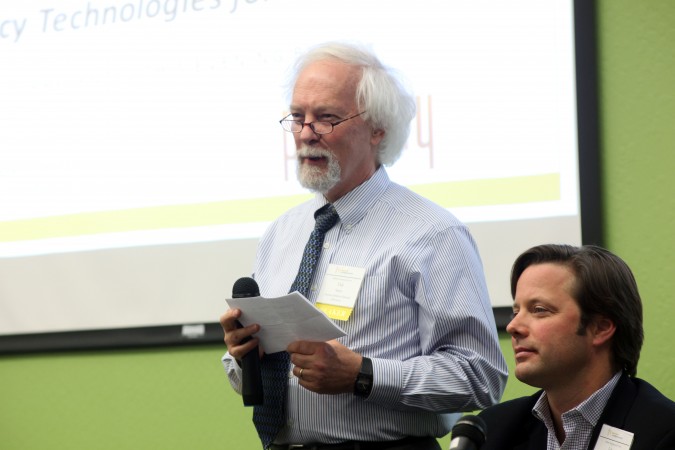
Dale Sartor, P.E., Applications Team - Environmental Energy Technologies Division, Lawrence Berkeley National Laboratory. Berkeley Entrepreneurs Forum, October 27, 2011

Joyce Dickerson, Sustainable IT at Stanford University, at Berkeley Entrepreneurs Forum, October 27, 2011

Sylvia Burks, Partner, Pillsbury Winthrop Shaw Pittman LLP, at Berkeley Entrepreneurs Forum, October 27, 2011
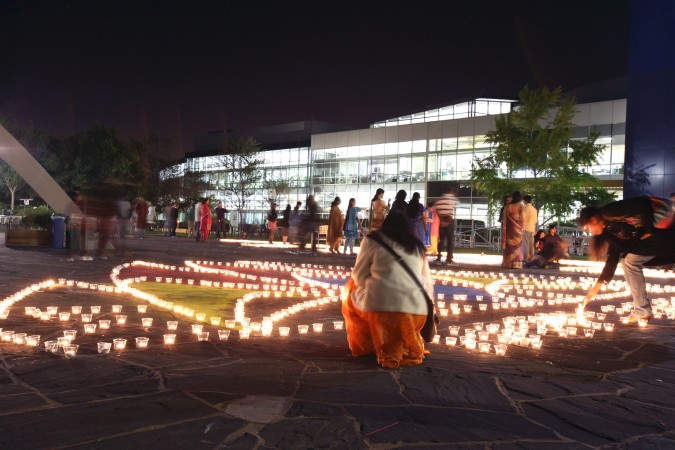
Diwali Festival of Lights with 6,000 candles at Google, Inc. headquarters in Mountain View, California, October 27, 2011. Photograph by Kevin Warnock.
[Note: I received a free pass to this event courtesy of my membership on the Advisory Council for the Berkeley Entrepreneurs Forum. I am writing here as a private citizen, not in any official capacity with UC Berkeley or the Berkeley Entrepreneurs Forum.]
Food Entrepreneurship: Surviving the Recession – Strategies to Remain Profitable in Hard Times

Networking hour at the Berkeley Entrepreneurs Forum, September 22, 2011. Photograph by Kevin Warnock.
The Lester Center for Entrepreneurship has been hosting The Entrepreneurs Forum for about 20 years. I have been attending the forums for about 19 years. I have written occasionally about some of the events, such as when the finals for the Berkeley Business Plan Competition are held.
I have never tried to simply write about each forum to spread the word about what goes on there. I am a big fan of the forum, and I like to blog, so you would think it would have occurred to me to blog about each forum. But I didn’t think to start regular blogging about the forum until yesterday afternoon, hours before the forum last evening.
I brought my Canon 5D Mark II DSLR camera and shot some stills and video. I uploaded the stills at full resolution. Click once on a picture to present it alone on a webpage, and then click a second time to enlarge the picture to full 21 megapixel size.
The title of the forum this month was Food Entrepreneurship: Surviving the Recession — Strategies to Remain Profitable in Hard Times.
Here’s the description of the event from the website of the forum:
“The Bay Area is home to many innovators in the food industry. Each year, new food start-ups crop up at the ready to take their products to market. It is a notoriously competitive industry, made more difficult in a down economy. Come hear from Noah Alper, the Founder and former CEO of Noah’s Bagels, and in-the-trenches executives of food companies as they discuss lessons learned in the challenges of a down market and how their companies have responded to them.
The evening will also include a special networking hour, prior to the panel, featuring displays from some of the Bay Area’s most beloved, as well as up and coming food companies including 18 Rabbits Granola & Bars, Alicia’s Tamales Los Mayas, Bridge Brands Chocolate, Casa de Chocolates, Fava, Slow Girl Foods and Sukhi’s Gourmet Indian Foods. [note I removed one of the companies linked to from the forum website because there appears to be a technical problem that needs to be fixed before visiting.]”
This session sold-out Andersen Auditorium last year and is not to be missed for anyone interested in the business of food!”
There were perhaps a dozen food businesses in attendance. To promote their products, each business set up a table in the Bank of America Forum, the large lobby area outside the Anderson Auditorium where the forum programs are usually held. The food was delicious and photogenic.
The panelists Bob Burke, Joel Gott and Noah Alper were engaging and entertaining. I learned a lot about the restaurant business, a business I knew little about before this forum. The panel was moderated by Greg Beattie, a Partner at MBV Law.
I was surprised to hear Burke give what I thought was a good word for Groupon, a company I don’t think much of. He said it’s expensive but it drives instant traffic into restaurants.
All the panelists were very bullish on social media. Burke said traditional media like print and radio has mostly been supplanted by social media. Burke advises some fancy restaurants. I was surprised social media is now so important to costly restaurants.
Perhaps the most famous panelist was Noah Alper, the founder of Noah’s New York Bagels, which he built into a chain of 38 stores before he sold them in 1995 for USD $100,000,000.00. Noah’s Bagels is an institution in the San Francisco Bay Area where I live.
Alper warned against giving out free product to drive store traffic. He said Noah’s Bagels tried that once and their stores were overrun with guests for the day of the promotion. However, he said traffic died back down to exactly normal just a few days later. The result was they had given away a ton of bagels for free with nothing much to show for it.
Gott said that the employees his businesses are able to hire during this recession are truly outstanding compared to during the original dot com boom in the late 1990s. He said they get stacks of resumes from great candidates. He said employees in San Francisco cost him 5% more than elsewhere, a figure I was surprised by since the City requires restaurants to provide sick days and health coverage, unlike almost all other jurisdictions in the United States.
I met and spoke with the founders of two of the exhibiters:
Casa De Chocolates — Arcelia Gallardo, chocolatier and owner — casadechocolates.com
I was drawn to Gallardo’s chocolate display by the sparkly sheen of the shiny smooth half spheres of rich chocolate. The sparkles were reminiscint of metalic automobile finishes — I’ve never seen such beautiful chocolate before. I spoke for a few minutes with Gallardo, and she told me how she got into the chocolate business. Sadly, I didn’t write any notes, and over the excitement of the rest of the night I forgot what she said. Here’s what the ‘about us’ page of her company’s website has to say about Gallardo:
“Arcelia Gallardo, owner and chocolatier, is passionate about pre-Columbian culture, chocolate and food. She started the company after graduating from UC Berkeley while working at the Le Cordon Bleu culinary school in Pasadena and has received training from world renowned pastry chefs Ewald Notter and Andrew Shotts. She was also a chef instructor at the Summer Cooking Academy in Los Angeles where she taught children and teenagers to work with chocolate.”
Derrick Sky — Mr. Derrick Jones, owner — www.derricksky.com (note that you must prepend ‘www.’ to derricksky.com or the website won’t load)
Derrick Jones started Derrick Sky in 2009 after he almost died due to his undiagnosed food alergies. I tried all of his company’s products on display without knowing the story behind them. The products were apparently all vegan, delicious, inventive and scrumptious. It turns out they are perfect for those with allergies. I normally avoid gluten free products since I’ve assumed they sacrifice taste. But Jones’ products were really tasty, and I wasn’t aware I was eating something special for those with restricted diets.
The Berkeley Entrepreneurs Forum is captured to video by a professional videographer. The full video is typically posted to the Lester Center website a couple of weeks after each forum. The official videos don’t include two key parts of each forum — the networking hour and a sequence of short ‘elevator pitches’ called ‘the numbers.’ I made a recommendation last evening to the videographer that he begin taking video of the elevator pitches. I think these pitches are part of what makes the forum special. I am fond of these pitches because I was a ‘number’ in early 1999 and I raised money for my first Internet company as a direct result of that pitch. I think these pitches should receive a wider audience than just those in the room, which is why I have decided to capture and publish them until the forum itself takes over, if ever. Note that I will be very upset if these videos are ever used to get somebody in trouble. The Berkeley Entrepreneurs Forum is a small gathering of smart people. If people ask for something in a pitch, please don’t give it to them casually. Investigate carefully, and be sure to comply with rules of the relevant authorities, such as the United States Securities Exchange Commission. By posting this clip and ones like it in the future, I do not intend to make any public offering, and I do not intend any harm to any presenter. I do not know any of the ‘number’ presenters.
[Note: I am a member of the Advisory Council for The Entrepreneurs Forum but I am writing here as a private citizen. The views I express here are my views alone, and I do not represent the Advisory Council, The Entrepreneurs Forum, The Lester Center for Entrepreneurship, the Haas School of Business or The University of California.]
The Secret History of Silicon Valley, by Steve Blank
I consider attending the Berkeley Entrepreneurs Forum to be one of the high points of each month during the academic year. The Forum is the premier event developed and hosted by the Lester Center for Entrepreneurship and Innovation at the University of California, Berkeley. I’m a member of the Advisory Council for the Entrepreneurs Forum, and I’ve enjoyed participating very much.
The draw for the evening is the speaker or panel on a subtopic of entrepreneurship. The action though is in the networking during the cocktail hour prior to the formal program and immediately after the program when there’s an opportunity to meet the speakers. I’ve shaken hands with more billionaires at the Entrepreneurs Forum than at any other single place.
The most recent program was by an individual speaker, my favorite format. The speaker was Steve Blank, the same Steve Blank I saw at the Commonwealth Club of California last month.
Blank delivered his talk entitled ‘The secret history of Silicon Valley’, which I had already watched on YouTube from an earlier presentation elsewhere. This talk is rich with colorful information about how Silicon Valley was formed. It’s a fascinating story tightly intertwined with Stanford University and World War II, of all things. I didn’t know this, I’m embarrassed to admit. But I would guess 99% of people don’t know this history.
I shot high definition video of Blank’s talk, but I have decided to link instead to the official version, which is edited with clear views of his slides. I’m not a fan of speaker slides generally, but these slides really do help tell the remarkable story more effectively.
I’ve heard Blank is an exceptionally engaging and likeable teacher, which probably explains why he won the Earl F. Cheit Award for Excellence in Teaching for the Berkeley-Columbia MBA Program last year 2010. Jerry Engel, the Faculty Director of the Lester Center, said in his opening remarks to Blank’s talk that he’s envious of Blank, since Engel hasn’t received this award.
Here’s the YouTube video of Blank’s talk, which happened February 24, 2011 in the Anderson Auditorium at the Haas School of Business on the UC Berkeley campus in Berkeley, California, USA.
Engel was a member of the board of advisors for my first company, Hotpaper.com, Inc. and is a member of the board of advisors for my current company, Silveroffice, Inc., the makers of gOffice, the first true online office suite, launched in 2004.
Steve Blank wrote what I consider to be the best book I’ve read on how to start a successful technology company — The Four Steps to the Epiphany, Successful Strategies for Products that Win.
If you consider yourself an entrepreneur, even if you’ve been successful for years, you need to own this book and read it multiple times, because you’ve probably just been lucky. Seriously.

